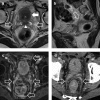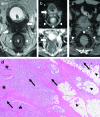Plasmacytoid urothelial carcinoma (PUC): Imaging features with histopathological correlation
- PMID: 28163816
- PMCID: PMC5262514
- DOI: 10.5489/cuaj.3789
Plasmacytoid urothelial carcinoma (PUC): Imaging features with histopathological correlation
Abstract
Introduction: Plasmacytoid urothelial carcinoma (PUC) is a high-grade variant of conventional urothelial cell carcinoma. This study is the first to describe the imaging findings of PUC, which are previously unreported, using clinical and histopathological correlation.
Methods: With internal review board approval, we identified 22 consecutive patients with PUC from 2007-2014. Clinical parameters, including age, gender, therapy, surgical margins, and long-term outcome, were recorded. Baseline imaging was reviewed by an abdominal radiologist who evaluated for tumour detectability/location/morphology, local staging, and presence/location of metastases. Pelvic peritoneal spread of tumour (defined as >5mm thick soft tissue spreading along fascial planes) was also evaluated. Followup imaging was reviewed for presence of local recurrence or metastases.
Results: Median age at presentation was 74 years (range 51-86), with only three female patients. Imaging features of the primary tumour in this study were not unique for PUC. Muscle-invasive disease was present on pathology in 19/22 (86%) of tumours, with distant metastases in 2/22 (9%) at baseline imaging. Pelvic peritoneal spread of tumour was radiologically present in 4/20 (20%) at baseline. During followup, recurrent/residual tumour was documented in 16/22 (73%) patients and 7/16 (44%) patients eventually developed distant metastases. Median time to disease recurrence in patients who underwent curative surgery was three months (range 0-19).
Conclusions: PUC is an aggressive variant of urothelial carcinoma with poor prognosis. Pelvic peritoneal spread of tumour as thick sheets extending along fascial planes may represent a characteristic imaging finding of locally advanced PUC.
Figures





References
-
- Guzzo TJ, Malkowicz SB, Vaughn DJ, et al. Penn clinical manual of urology. 2nd edition. Philadelphia, PA: Saunders; 2014. Chapter 16 Adult genitourinary cancer; pp. 505–8.
-
- Wood DP. Campbell-Walsh Urology. 10th edition. Philadelphia, PA: Saunders; 2012. Chapter 80 Urothelial tumours of the bladder; pp. 2309–34.
-
- Lopez-Beltran A, Sauter G, Gasser T, et al. World health organization classification of tumours Pathology and genetics of tumours of the urinary system and male genital organs. Lyon: IARC Press; 2004. Infiltrating urothelial carcinoma; pp. 93–109.
-
- Sahin AA, Myhre M, Ro JY, et al. Plasmacytoid transitional cell carcinoma. Report of a case with initial presentation mimicking multiple myeloma. Acta Cytol. 1991;35:277–80. - PubMed
-
- Zukerberg LR, Harris NL, Young RH. Carcinomas of the urinary bladder simulating malignant lymphoma. A report of five cases. Am J Surg Pathol. 1991;15:569–76. https:/doi.org/10.1097/00000478-199106000-00005. - DOI - PubMed
LinkOut - more resources
Full Text Sources
Other Literature Sources
